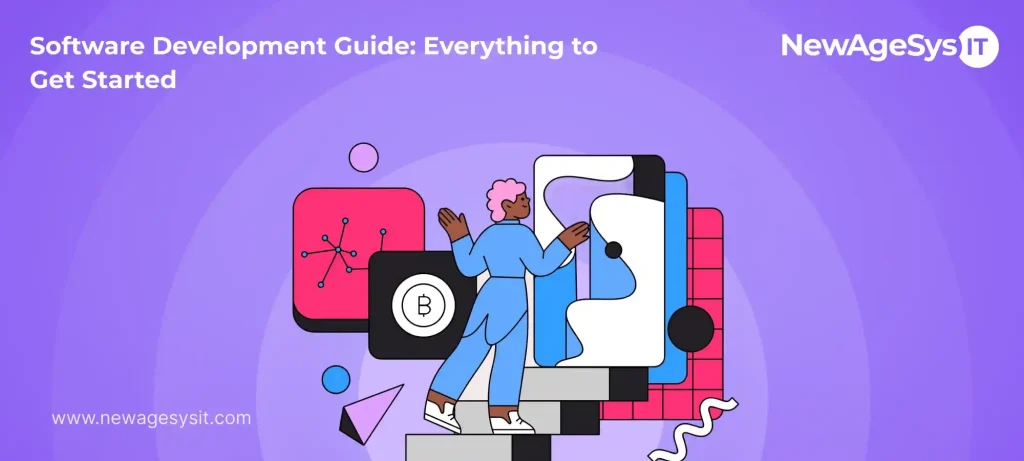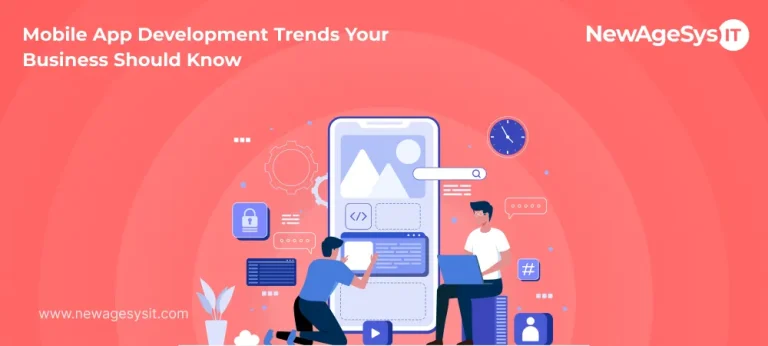| TL; DR Software development has been transforming the digital segment with benefits like automation, customer engagement, and innovation across multiple industries. The global software development market is experiencing rapid growth, projected to reach over $900 billion by 2030, with the United States leading in revenue generation. A structured and aligned Software Development Lifecycle (SDLC) ensures on-time delivery, better quality, risk management, and streamlined project execution. There are various software development models—Agile, Waterfall, DevOps, Spiral, and others; you can choose from, depending on your project scope and flexibility needs. Custom software development offers tailored solutions, better scalability, and long-term ROI compared to off-the-shelf software. Custom software development costs can range between $100,000 and $1,500,000 or even more. |
Software development has had a significant impact on our lives, particularly in businesses, due to its scope in developing applications and platforms that make lives easier and businesses more prosperous. The global spending on enterprise software development amounts to $ 1 trillion, according to a recent Statista report. That said, regardless of the business size and complexity, organizations have been using software to manage their everyday operations. With a software development guide, businesses can learn and delve deeper into the key aspects to consider when hiring a software development company or developing business software.
We’ve picked some interesting stats from the Statista Software Worldwide Market Insights; have a look:
- The software development market volume reached 316.69 billion USD in 2025.
- The market is expected to achieve a steady growth rate of about 3.98% by 2030.
- The expected market volume by 2030 is 902.74 bn USD.
- Considering the global software market, the USA is expected to generate the highest revenue.
Undoubtedly, software development has been witnessing one of the highest growth rates compared to other technological segments. From this blog, you can gain a detailed guide to software development, including the processes, models involved, and associated costs.
What is Software Development? Understanding the Concept, Purpose & Principles
Software development refers to a chain of activities involved in the development, management, and maintenance of applications or any software components. It defines writing and maintaining the source code, but at an enhanced level. Software development typically encompasses a range of activities, including planning, development, modification, engineering, and maintenance. Searching for the purpose and importance of software development? Let’s draw the key terms in this software development guide:
- To identify the specific needs of a particular client, business, or organization, i.e. custom software is used.
- To understand the requirements of a common user set, which is usually found in commercial or open-source software.
- To meet the needs for personal use, which is referred to as personalized software.
Software developers, programmers, and engineers provide software development services. Based on the development departments, these roles might overlap, and the dynamics among them can also differ.
Software developers are usually engaged in writing code. They lead the Software Development Lifecycle (SDLC). This is a key process that requires collaboration with cross-functional teams, converting needs into features, managing the development process, overseeing team management, implementing software testing, and ensuring maintenance.
Software programmers (also known as coders) write the program code to carry out tasks such as routing communications, merging databases, and displaying text. They typically gather instructions from software developers, software engineers, or both. They generally use Java, JavaScript, and C++ to perform the instructions.
Software engineers solve problems by applying their knowledge and engineering skills to the product/software. With the help of tools, software, languages, and frameworks, they create solutions. By adhering to the scientific methods, they ensure their solution is perfect in the real world. Software development is a highly evolving field with great demand, and the dynamic market makes it an industry with numerous opportunities.
According to recent reports, the employment rate for software developers is expected to rise by at least 25% from 2021 to 2031. These growing demands have also pushed organizations to hire software developers due to the diversity of work and the need for vetted professionals.
Importance of Software Development
We have created this detailed guide to software development because it has significantly influenced businesses in enhancing their sales, marketing, and brand value. Software development enables businesses to stay more competitive and differentiate themselves from others. It enables businesses to be highly innovative and enhances the customer experience. According to the Business Research Insights report, approximately 71% of the surge in software demand has been concentrated on business automation and custom enterprise-level software, emphasizing the importance of software development.
Software helps store, unify, and integrate data, providing users with easy access to it. Hence, software development should also consider ensuring data security and data protection.
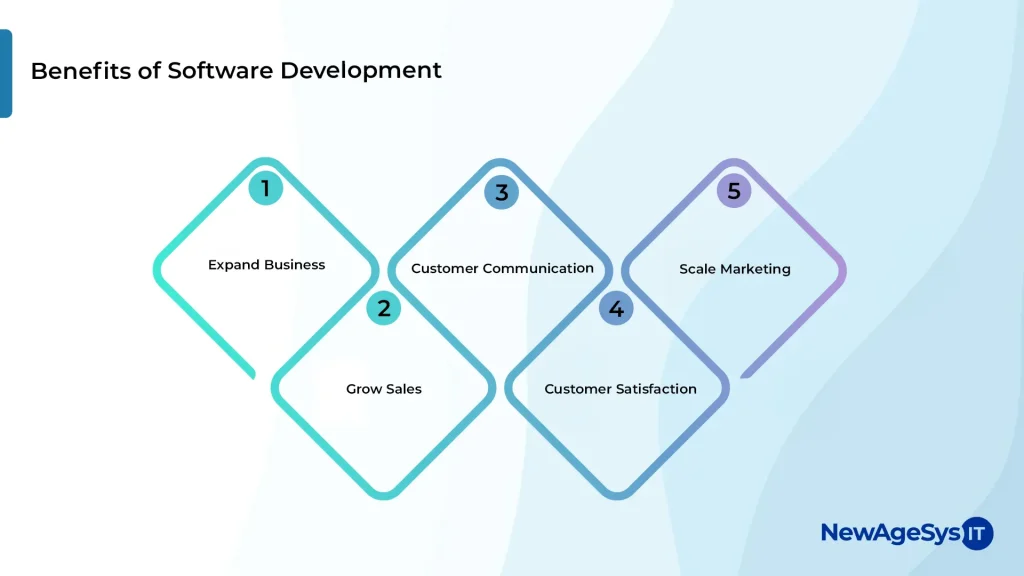
In this software development guide, let’s discuss in detail the benefits of software development.
- Expand Your Business
It helps you promote your business and spread brand awareness, which is the key importance of software development. It helps your brand and business extend across borders, thereby maintaining excellent global visibility.
- Grow Sales & Services
Ensuring the digital presence of your business through software development enables you to enhance your sales growth and drive business success. It is essential to understand what your customers perceive about the brand and its offerings. So you need to have an online platform where customers can contact you.
- Direct Customer Communication
Software development enables you to communicate directly with customers and engage them, which are the key benefits of software development. This is the quickest way to expand your brand awareness.
- Improve Customer Satisfaction
Online marketing with marketing software enables you to enhance customer loyalty and foster high customer engagement. Businesses should adopt an effective marketing strategy to deliver exceptional customer satisfaction and retain customers.
- Helps in Marketing
With software development, you can scale marketing without investing additional time, cost, and effort. Building software and working on marketing helps you reach customers anywhere in the world.
Industries that Benefit From Software Development
Adopting custom software development can benefit every industry to benefit, regardless of the sector. As discussed above, your business can gain numerous benefits from software development. Here is a snapshot of the industries that can benefit from software development.
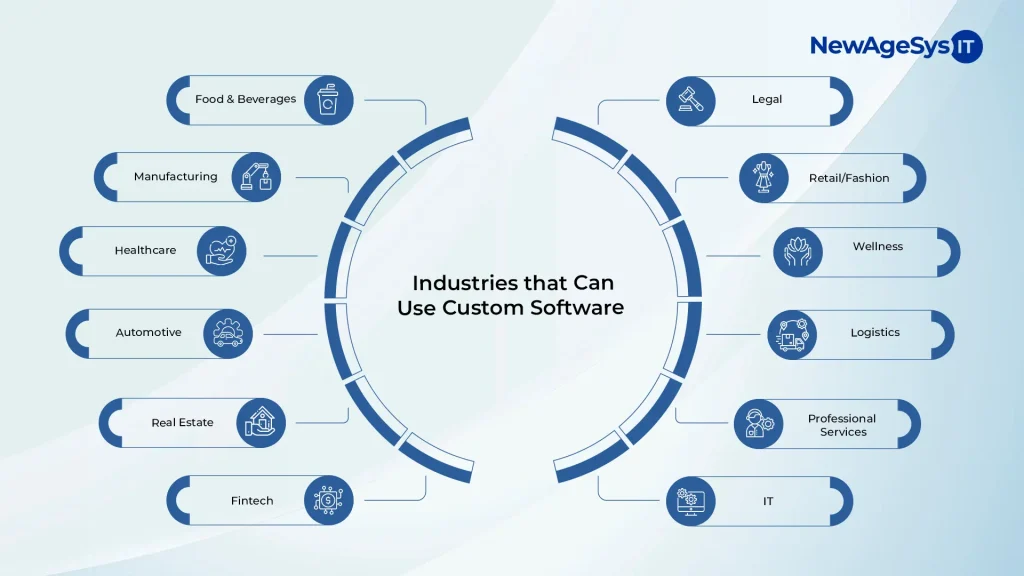
Types of Software Development
In this guide to software development, let’s also discuss the types of software development in detail.
Application Software Development
The process involves developing software applications that enable your business to achieve its objectives and perform tasks efficiently. Application software development can take various forms, depending on the chosen platform or operating system. To build applications, you should also be familiar with programming languages like Java, C, C++, Python, etc.
Custom Software Development
As the term states, it refers to building software that serves the unique business needs. For instance, when you want to build software with specific functionalities and fulfill the purpose of targeting users, custom software development is ideal. You generally use Javascript, HTML, CSS, Java, or PHP to build custom software.
Web Development
Being one of the best types of software development, it builds web-based platforms, including web app development, website development, and web portals, optimized for use in browsers. This process encompasses web publishing, web design, database management, programming, etc. Developers use CSS, HTML, and JavaScript to design the functionality, style, and web page layout.
Mobile App Development
One of the most prevalent types of software development, mobile app development is an essential requirement for businesses following the surge in mobile device usage. This process involves development of an application that works across mobile devices. Mobile app development is performed across two primary native platforms: iOS and Android.
API Development
Also known as an Application Programming Interface, an API involves developing a specific type of program that enables various software systems to interact, share data, and implement particular tasks with defined parameters and data. With a set of requirements and instructions, APIs enable applications to utilize external services or functions.
Embedded Software Development
It embeds software within the hardware to control machines and devices, such as phones, robots, and automobiles. When you hire embedded software developers, they should know C, assembly languages for embedded devices (Arduino, Raspberry Pi). By building software that is highly integrated with hardware, businesses can improve system performance, minimize resource consumption, and gain greater control over the product’s functionality.
Cloud Software Development
It builds an application that runs across a cloud environment. It replaces local servers or dedicated devices, with remote servers and networks. Azure, GCP, or AWS cloud-based service providers offer cloud computing, local networking, storage options, and software development methods. With cloud application development, your business can experience flexibility, cost-effectiveness, collaboration, and scalability.
Database Development
Database management involves developing the system’s backend. It enables businesses to store, retrieve, and manage data in a structured and organized manner. Database developers employ DBMS (Database Management Systems) to execute and manage databases. Relational database management systems, such as NoSQL databases, are examples.
What is the Software Development Lifecycle?
SDLC, or Software Development Lifecycle, is a process software development companies use to design, build, and test the software. With SDLC, you can create high-quality software that aligns with business needs and customer expectations, and meets completion within the specified time and budget. The SDLC has a defined set of tasks that are performed at every phase of the software development process.
Why is Software Development Lifecycle (SDLC) Important?
- It is a project management guide.
- It helps to define the goals clearly.
- It is beneficial in scheduling, assessing, and eliminating deliverables.
- It is useful to meet the client’s expectations.
- It is a framework for performing a specific set of tasks.
- It ensures timely delivery to the client with accuracy.
- It ensures complete project testing.
- It maintains optimal control and minimizes project risks.
- It offers project flexibility.
- It carefully analyzes the project.
Software Development Lifecycle: What are the Key Phases?
SDLC (software development lifecycle) undergoes a typical yet long software development process. We have included the phases in detail in this software development guide.
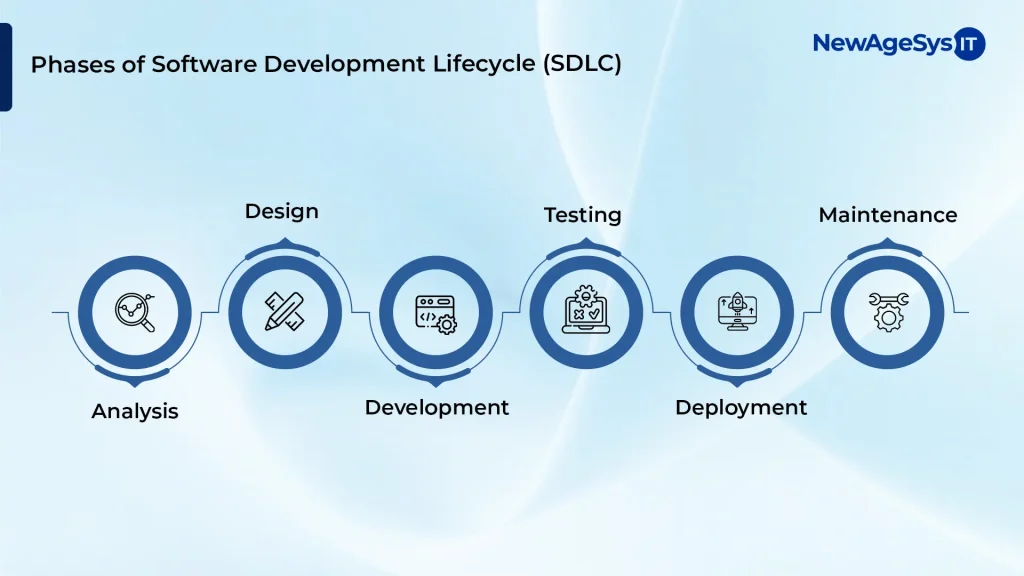
1. Analysis
It evaluates a software project based on its objectives and requirements. In this phase, you document users’ specifications, recognize stakeholders, perform feasibility checks, and define project criteria.
Major Steps:
- Define the case
- Understand the project’s scope
- Define key objectives
- Specify deliverables
- Create a project schedule
- Assign the task to the team
- Implement risk analysis
- Report and track progress
Jira, Mavenlink, Kissflow Project, and Adobe Workfront are examples of project planning tools.
After gathering the requirements, you can segregate the business requirements from the software requirements. At the end of the phase, the SRS (Software Requirements Specification) document is finalized, encompassing all project requirements.
2. Design
In the design phase, the blueprint is created to specify the technical conditions and design the software architecture, including the modules. It also involves designing databases and data models, as well as creating UI mockups/wireframes.
Software design process has three phases, namely:
- Architectural design: Highest level of abstract version, where designers get a better idea about the proposed solution.
- Preliminary or high-level design: The problem is broken down into a set of modules, and structured charts and diagrams are implemented to represent the problem.
- Detailed design: Considered after completing high-level design. This version is more detailed for the module and the implementation.
What is prototyping?
In the design phase, an incomplete software product or application version is developed. This is called prototyping, which is a working model of software with limited capabilities.
With prototyping, you can save on time and costs, improve products with high user satisfaction, and scale the overall product quality.
3. Development
At this stage, developers frame the code according to the design specifications to develop the software. This includes deploying features and functionalities, integrating software, creating technical documentation, and optimizing the codebase following review.
Generally, software development is classified into two types of coding areas: Frontend and Backend.
- Front-end development, also known as client-side development, involves the development of HTML, CSS, or JavaScript for a web application or website, where users can directly see and interact. Frameworks include ReactJS, Angular, Vue.js, jQuery, Flutter, etc.
- Backend development is server-side development, which emphasizes how the website functions. It consists of three components: the server, the browser, and the database. Backend developers write code that interacts with these components. The examples include Django, Laravel, Ruby on Rails, ExpressJS, and CakePHP.
4. Testing
This phase includes implementing in-depth testing of software products to detect and fix potential bugs or glitches. It involves designing detailed test cases, implementing various testing types, documenting and communicating test results, and implementing UAT (User Acceptance Testing).
Testing approaches can be divided into:
Black box testing: The software app’s functionalities are tested by testers who know only what the software does, but not how it performs the job.
White box testing: In this type of testing, the design, code, and internal structures are thoroughly examined. The most prevalent type is unit testing.
Grey box testing: This involves testing software apps or products with partial understanding of their internal structure.
Let’s also look at certain popular types of testing:
| Type of Testing | Role/Function |
|---|---|
| Unit Testing | Single/interrelated units are tested. |
| Integration Testing | Group of components combined for testing. |
| Regression Testing | Testing added modules to ensure the software or application works properly. |
| Smoke Testing | Testing to determine if software is stable or not. |
| Alpha Testing | Validation testing is usually done before delivering software to the customer. |
| Beta Testing | Real-time testing environment for limited users. |
| System Testing | Tested to see if the software works across different operating systems. |
| Stress Testing | Testing beyond the standard operating environment limits. |
| Performance Testing/Load Testing | Tests how well app performs under various conditions. |
| (OOT) Object-Oriented Testing | Validates individual classes. |
5. Deployment
It releases software to the final stage, as the customers can see. It includes creating deployment packages, configuring server, data migration, user training, and provision of documentation.
Here are the steps to follow during software deployment:
- Have a deployment checklist
- Select the ideal deployment method
- Automate deployment
- Implement Continuous Delivery (CD)
- Utilize Continuous Integration (CI)
6. Maintenance
In the maintenance phase, the process involves monitoring system security and performance, providing ongoing user support, addressing support tickets, and making modifications based on user feedback.
Why do you need software maintenance?
Software maintenance is crucial for your business to ensure that you can improve design, eliminate bugs, implement enhancements, adopt new programs, and migrate legacy software. With maintenance, you can keep the software highly reliable. It adapts to the new technologies and helps optimize software performance. Without software maintenance and support services, software can remain inefficient. Nevertheless, it can be vulnerable to security attacks, causing financial and reputational damage.
What are the types of Software Maintenance?
Maintenance is categorized into:
- Corrective Maintenance: Implemented to rectify the bugs and enhance performance.
- Adaptive Maintenance: performed when the user wishes to run on a new OS/platform using new hardware or software.
- Perfective Maintenance: Executed when customers want to incorporate new features into the software.
- Preventive Maintenance: Done to prevent software from problems in the future.
Software Update: Why is it Essential?
A software update is the ideal way for software developers to manage and modify software, making it the best. Software updates don’t involve major changes, but only frequent step-by-step fixes. It can sometimes run automatically in the background, or you can download it manually. Software updates ensure that the product or an application runs smoothly.
Software updates are helpful in:
- Staying protected against security threats.
- Fixing bugs and enhancing functionality.
- Achieving new features.
SDLC Models & Methodologies
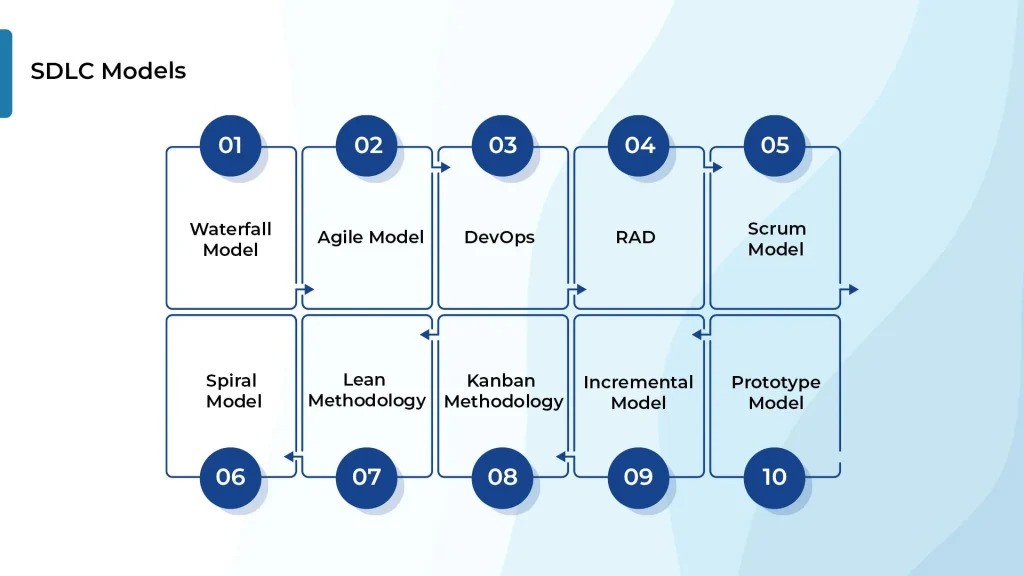
The software development team adopts the SDLC (Software Development Lifecycle) model in the software development process to efficiently manage projects. Based on the project requirements, developers choose the set of software development methodologies, or SDLC models.
Every SDLC adheres to a series of steps, which collectively contribute to the success of software development. Let’s take a look at an overview of the most common SDLC models in this software development guide, i.e., Software Development Methodologies, in the software development segment.
Waterfall Model
As one of the oldest SDLC models, the Waterfall Model, otherwise called Linear Sequential Lifecycle Model, is the easiest to use. It restricts the overlapping of phases, so every phase must be completed before proceeding to the subsequent. The outcome of a phase is literally an input to the subsequent phase in this model. Here is the sequence of phases in the model:
- Requirements Gathering and Analysis
- Design
- Implementation
- Integration & Testing
- Software Deployment
- Software Maintenance
Agile Methodology
In this software development process, there is a continuous development and testing iteration in the SDLC. According to the methodology, the whole software development is classified into segregated incremental components. Each iteration lasts between 1 and 3 weeks, depending on the development project.
Let’s understand the values of the methodology:
- Team/individual interaction with the tools and the processes.
- Working software/app over documentation.
- Customer Collaboration rather than negotiation.
- Response to changes rather than sticking to a plan.
DevOps
DevOps software development infuses the Dev (software development) and Ops (IT operations) in the SDLC. DevOps is a set of practices that contribute positively to the organizational culture. DevOps enhances collaboration among various departments within a software development organization. It also helps to improve collaboration between the SDLC phases, namely, operations, development, and quality assurance. The key objective of DevOps is to lower the SDLC duration. It also ensures the frequent delivery of features, fixes, and updates.
RAD (Rapid Application Development) Model
It focuses on quality-bound software development that developers can use to quickly adjust and meet the business-specific needs at low cost.
RAD includes the following phases:
- Business Modeling
- Process Modeling
- Application Generation
- Testing/Turnover
Scrum Methodology
Scrum classifies software development into tiny modules. Every module adopts an independent strategy. Like Agile methodology, this is yet another well-known software development methodology. It lets a series of iterations in a stretch. It has three sequential phases, namely,
- Planning
- Meetings
- Conclusion
Spiral Model
The SDLC model offers risk handling support. The spiral model enables the grouping and adoption of multiple process models. The spiral model begins with smaller software development aspects and further moves towards larger aspects. Risks at each step are managed first, after which the next iteration is adopted. Each phase in the model is classified into four quadrants with functions as below:
- Determining objectives and identifying alternative solutions
- Identification and resolution of complex risks
- Building the product’s next version
- Review and plan the subsequent phase
Lean Methodology
The Lean model focuses on optimizing time and resources, as well as creating software that is easily adaptable and scalable. Its goal is to develop software in the shortest time and at the lowest cost. After the MVP (Minimum Viable Product) development, it is released to the market, and additional functionalities are added based on feedback. It requires the support of expert software developers who can assist with software development.
Kanban Methodology
This software development approach addresses work-in-progress and JIT (Just-In-Time) principles. This model enables software development firms to work on their existing workflows and adopt evolutionary improvements. The Kanban methodology focuses on managing the flow of features to maintain a steady number of features entering the process, equal to those that are completed.
Incremental Model
An incremental model is simply a series of waterfall cycles. At the beginning of the SDLC, these requirements are grouped together. Every group follows the SDLC model. Until each requirement is met, the software development lifecycle gets repeated. In this model, each SDLC takes the place of the maintenance phase for earlier software releases. Any changes to the software lead to overlapping development cycles.
Prototype Model
It involves creating a prototype, testing, and refining it until it fits the requirement. You can go for the model when you don’t have precise needs to follow. It involves a trial-and-error approach between developers and the clients.
The prototype model has the following phases:
- Requirements Analysis
- Design Planning
- Prototype Development
- User Evaluation & Feedback
- Prototype Refinement
- Product Deployment & Support
Software Development Tech Stack- What Are They?
The software development toolkit typically consists of the tools developers use to build a highly functional software/application.
Let’s break down this software development tech stack in our software development guide:
Programming Languages
Various languages have diverse applications. JavaScript is primarily used for frontend development, whereas Python is typically used for backend development. The top programming languages used for software development include Python, Java, HTML/CSS, JavaScript, TypeScript, SQL, C#, and others. According to the recent Stack Overflow Survey, JavaScript was chosen as the top popular technology among other programming, scripting, and markup languages.
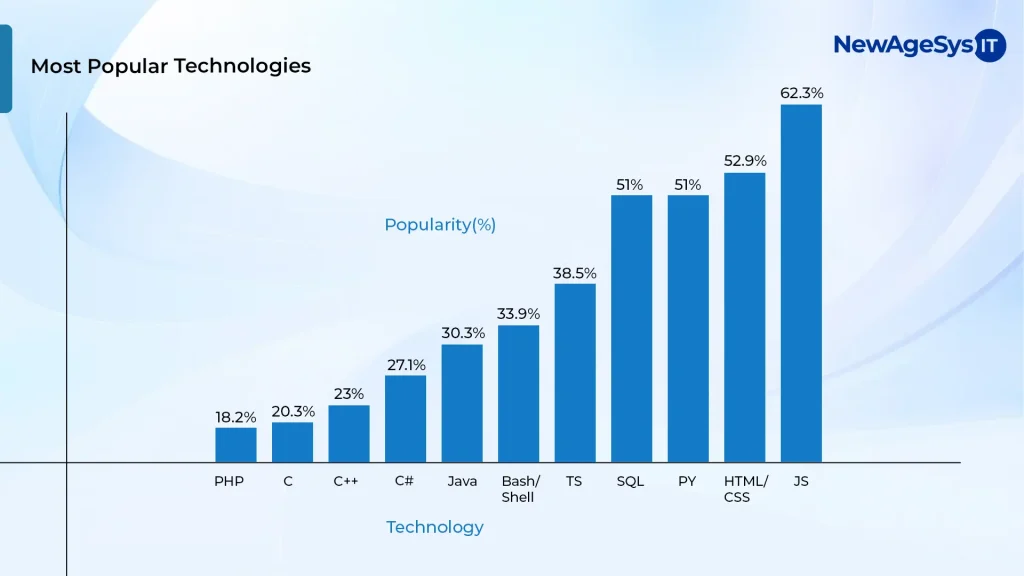
Frameworks & Libraries
Written with programming languages, they aim to simplify development, enabling developers to use reusable components. According to the Stack Overflow Developer Survey, the most preferred frameworks/libraries are React, followed by Node.js, and then Next.js.
Tools
The software development tools offer various utilities and functionalities to build and manage development, thereby enhancing product quality. The common tools in use among global developers, according to the Stack Overflow Survey, include Docker, npm, pip, Homebrew, and Make.
Databases
Databases help store, manage, and gather data needed for your software systems. By using various mechanisms, you can classify and query structured data.
Software Development Approach: What Suits Your Business the Most?
Custom software development is a great choice when businesses require a precise solution tailored to their specific needs. It provides high-end customization for software and ensures alignment with company-specific workflows, enabling great efficiency in business operations. The customized software development process helps increase user satisfaction and efficiency, while also providing the flexibility to scale the software as the business evolves. How to choose the right software development approach for your project? Let’s explore the various development and outsourcing models and types of software outsourcing in our software development guide.
- Custom Software Development
This involves using tailor-made software solutions that meet the specific business needs. Custom software development should be your choice when:
-Your business has specific operations that can’t be supported by an internal team.
– You need to evolve the system quickly with flexibility.
– You wish to stand out in terms of technology and market presence.
- Off-the-Shelf Software
Off-the-shelf software can be a comfortable option for quick deployment. However, it can specifically lead to compromises in efficiency and functionality. These solutions can address the lack of major business-centric functionalities and unnecessary features. Depending on outside vendors for support can also be challenging, especially if the product is discontinued or fails to comply with the company’s changing demands.
- Staff Augmentation
The model helps maximize the efficiency of the in-house development team while controlling software development outsourcing. In staff augmentation, the client borrows either a software development team or a portion of a team from another organization for a specific period. In this case, the borrowed team plays a key role in your process to complete the assigned tasks. Consequently, the software development team assigns responsibilities to the client itself.
- Project-Based Outsourcing
This model is an ideal choice for organizations that require custom software development but lack an in-house software development team to handle the task. Here, the client assigns the project to a third-party service provider. The client sets a deadline, and the agency/company provides the software accordingly. The outsourced software development company bears the responsibility for the entire project.
- Dedicated Team Model
This is somewhere between staff augmentation model and project-based outsourcing. It includes a dedicated development team who can work on specific tasks or projects. This entire software development is held outside the client’s organization. The project manager shares the project’s progress and status with the client. Most fast-growing companies use this model for software development.
Software Development Costs: How Much Should You Spend On Your Software?
Custom software development costs can generally vary from $100,000 to $1,500,000 or even more. In this guide to software development, let’s break down the core factors that can affect custom software development cost:
- The type of application (mobile or web, or desktop), the platforms or OS it supports.
- The extent of software features and its complexity.
- The user roles.
- Uniqueness and UI/UX design specifications.
- Complexity of integrations and their scope.
- Security expectations, performance, and scalability requirements.
- Regulatory compliance expectations. (GDPR, PCI DSS, HIPAA, SOX, ISO 27001, etc.)
- Preferred sourcing model and team.
- Development strategy and the technologies.
- Software update and frequency of changes.
Factors to Consider While Choosing a Software Development Services Provider
Team Expertise
Choose a partner with relevant industry experience in developing custom software. Understand their track record, client testimonials, and portfolio to learn about their skills, capabilities, timelines, and the work quality.
Technical Excellence
Your development experts should hold the necessary technical skills and expertise to implement the project. Understand their programming language proficiency, knowledge of databases, frameworks, and other technologies.
Project Management Methodology
Know what approach the partner adopts for project management. You can ensure great collaboration with a transparent process, frequent updates, and great communication. You can always rely on agile methodologies to achieve flexibility.
Customization Capabilities
Let the service provider understand all your business needs, so that they can build a solution that aligns with the business’s purpose. Additionally, consider the partner’s ability to scale the software as the business grows and its needs change.
Quality Assurance/Testing
Enquire about the quality assurance and testing methodologies of the vendors. With robust testing, you can ensure that software is error-free and performs the best, while meeting stakeholders’ preferences.
Data Confidentiality & Security Measures
The provider should adopt top-notch security measures to secure data against unauthorized security threats. Also, share confidential agreements to protect the intellectual property.
Team Engagement & Clarity of Communication
The development team should interact well with the client to establish a thriving partnership. See if the partner maintains clear communication, and assesses their ability to understand what the client wants.
Cost Considerations
Take a detailed look at the vendor’s pricing model and check if it aligns with the project’s budget. Learn about the value they offer: quality, experience, expertise, and deliverables.
Maintenance & Support
Look for the partner that provides post-development support. Software needs updates, consistent support, and bug fixes. Ensure that the vendor provides high-end support services to address core issues that may arise once the software is deployed.
Client Feedback
Gather client references from potential vendors and obtain information and feedback from their previous clients to assess their genuineness. This can let you understand how professional the vendor is and ensure if they’re reliable.
Conclusion
As a complex process that demands tech expertise, custom software development requires thoughtful planning and a combination of talent and expertise to successfully complete the process. However, custom software applications offer a range of benefits tailored to your organization’s specific needs.
Hope you’ve enjoyed going through our software development guide. If you wish to consider customizing your software or building it from scratch, you should work with a reputable software development team that has industry expertise. Hiring experienced developers or seeking the assistance of an established software development company like NewAgeSysIT can help keep your software solution purpose-ready and impress your customers. In addition to this guide to software development, our team can also offer you custom software development services. To learn more, contact us today.
FAQ
1. How do I select the right tech stack for my software project?
To select the ideal tech stack for your software, consider the project’s scope, goals, and target audience. Then compare performance, scalability, team expertise, security, and cost. Also, consider the technologies and opt for the stack that best suits your business’s needs.
2. What is the cost of developing software?
Software development costs can vary based on complexity, team location, technologies, and the scope of the software. Custom software development can generally cost between $100,000 and $ 1,500,000+.
3. How much does it cost to hire a software developer in the USA?
The cost of hiring a software developer in the United States can range from $75 to $160 per hour. If you are searching for a dedicated developer for your next project, you can hire a software developer at less cost.
4. How to calculate app cost?
App development costs can differ according to your project’s complexity, functionalities, team size, and timeline. To know how much your app costs, you can calculate app cost here.
5. Do you offer software maintenance and support?
Absolutely yes. We deliver maintenance and support services to keep your software applications highly functional and secure. These services help you keep your software free of bugs, secure and highly performing.

